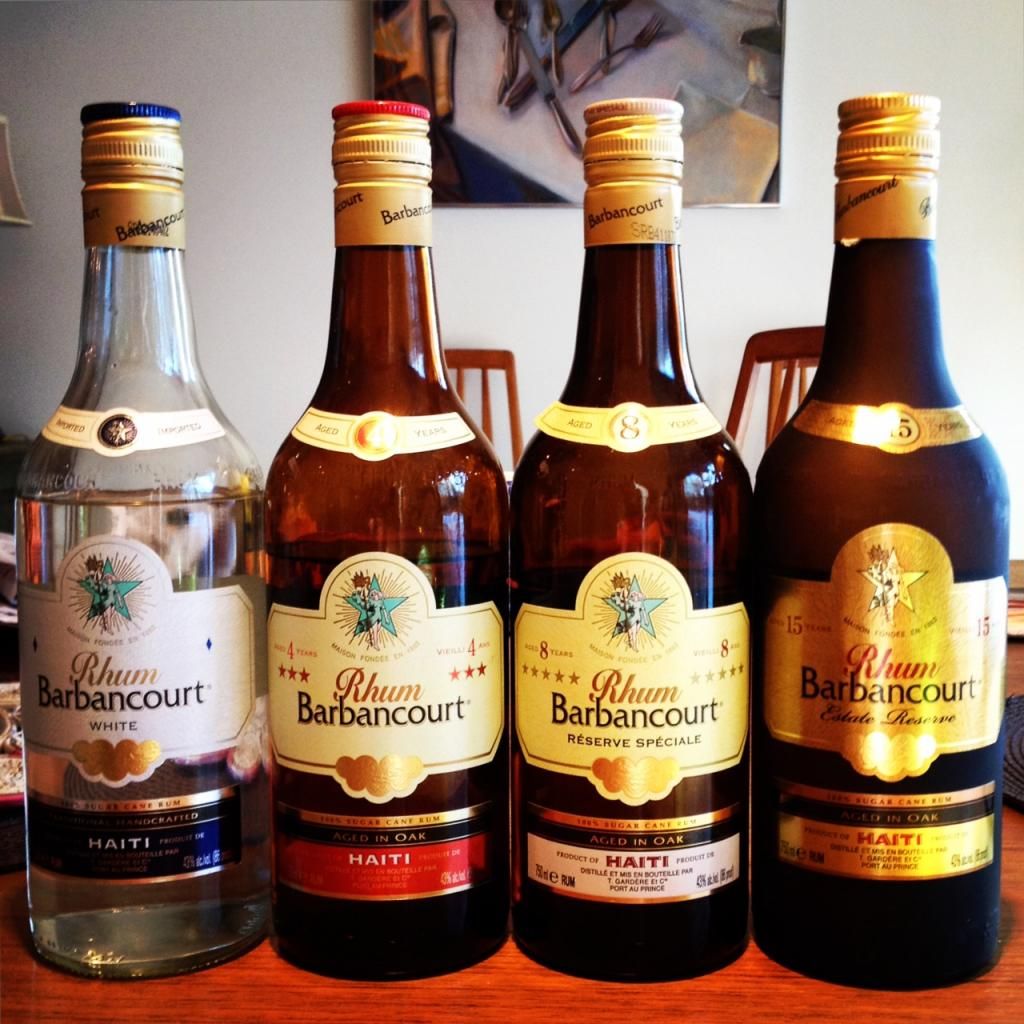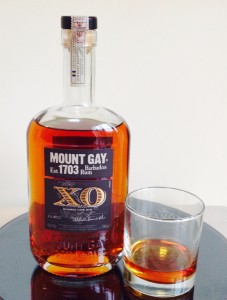The precursor to this post was a comment by "RT" wondering how his beloved 15 Year compared to the 8 Year. Sue Sea and I had tasted the 15 (I knew this because about a third of the bottle was gone), so I looked for the review I was sure we'd done.
Missing!
What?! I know we tasted this rum, but somehow the notes must have been lost. And a rum owned is a rum reviewed around here. So I begged Sue Sea to join me in a retaste (which didn't take much persuasion, I might add). And in setting it up thought we really ought to do a comparative flight with the Three and Five Star. Later we added two other rums (more anon).
So we engaged in our usual set up.
Lights down, fish tank lit, all three bottles on the lazy susan (couldn't resist, Sue Sea), and both of us with three of our tasting glasses from IKEA, with a decent pour of each.
What was especially interesting about this comparison is that - in the case of Barbancourt - we are dealing with a product line whose only difference is that of aging, and not blending. Thus we could learn what age and good Limosin oak accomplishes with the product.
Great!
Unlike our typical reviews, the following are our joined impressions. It might be beneficial if you first read the full reviews of all three:
Barbancourt Three Star (4 year):
Barbancourt Five Star (8 year):This of course is the youngest of the three, and sets the stage for further aging. The Three Star is the least complex, but entirely pleasant. The dominant aroma is undeniably of reedy cane which clearly establishes the cane juice origin of this rum. Any sweetness, et al, is underneath. Three Star presents as clean and crisp. In the mouth it opens smooth and almost sweet, but explodes into a caney, white peppery hot and noticeably astringent finish with a lingering peppery aftertaste. Think "Hot Lips Houlihan".
Think hollow, from an opening, single minded cane aroma, to an explosive peppery cane finish.
Barbancourt Estate Reserve (15 year):With the foregoing in mind, the Five Year presents quite differently. Now a vanilla sweetness has come forward, in pleasant balance with a the reed, over oak. The reed has retreated but is still nicely evident and is now in balance. The entire sensation is crisp, light and refreshing and consistent with the more balanced aroma. More complexity is evident. The body is now medium (rather than light). The finish remains peppery but seems smoother, and with less atringency.
Think smooth, balanced and more complex.
Bottom Line:Now what has age accomplished? Aromawise we now experience yet more complexity, with the reed retreating much further into the distant background. Vanilla, caramel, maple, a robust orange leather and a tarry/oakey furniture polish - all similar to a molasses based profile - have emerged and come to the foreground. The rum is now full bodied and displays vigor throughout. The cane is still there, but some may not realize this is a cane juice rum. The taste remains consistent and balanced. The finish is now almost syrupy hot and peppery.
I stress almost. Think full bodied, balanced, smooth, complex and powerful.
This was truly an eye-opening experience.
The effects of oak and aging are dramatic. The reedy/caney origin of these cane juice rums are reduced by aging. By 15 years only a remnant of the origin remains. By 8 years the rum is more balanced and smooth and vanilla, a light nuttiness, sweetness and oak have emerged. Body is now medium. By 15 years and the end of effective aging, the deep orange and tarry leathers have come forward. The burnt sugars and carmelisation of the oak is clear. The finish is hot, sweet and peppery. The effect is now robust, full bodied and once again pungent, although more complex.
I believe the reason the 8 year Five Star dominates the ratings is because it has achieved great smoothness, balance and complexity but without being anywhere near overdone. The 15 year is still wonderful, but is pushing the edge. The 4 year Three Star has many of the elements of the Five Star, but they have not yet emerged, leaving the cane dominant (wonderful in its own way).
Just for fun we pulled out the highly marketed "10 Cane". In comparison to Barbancourt's Three Star, the 10 Cane had little going on. The Three Star came across as richer and warmer, more complex. The 10 cane was thin, smelled of alcohol, and the lightest possible cane. Otherwise it was very light, very smooth. Let's call it the Vodka of rum.
Last, we poured a dram of - you'd never guess - the new Zaya 12 year (Trinidad). Why? Because it represents the end point of hot, sweet and syrupy. Of course this was compared with Barbancourt's 15 year, which was described in similar terms. If we had any doubt that the Barbancourt had gone too far toward those ends, Zaya demolished this notion. When compared to a truly sweet, truly syrupy hot rum, the Barbancourt 15 year demonstrated where the line really is. And the background cane became more apparent.
All in all, an extremely fun and educational evening. I cannot stress enough: if you want to learn about aging, you can do no better (nor more economically) than this comparison.
Up spirits!



